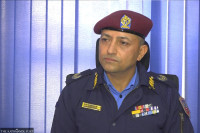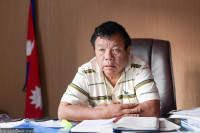Interviews
‘Hope in short supply in Madhesh this election season’
Political analyst Tula Narayan Shah on how observers see the political scenario and how are the Madhesh-based parties expected to fare in the upcoming provincial and national elections.
Nishan Khatiwada
Hot to trot for November polls, Nepal’s political parties have begun electioneering— holding informal rallies and interacting with locals. Two electoral alliances, one led by Nepali Congress and the other by CPN-UML are going head to head. And of the two major Madhesh-based parties, Janata Samajbadi Party is a partner in the UML-led alliance while Loktantrik Samajbadi Party is in the Congress-led one. How are political observers seeing this pre-poll phase? And what is the state of the Madhesh-based parties? The Post’s Nishan Khatiwada spoke to political analyst Tula Narayan Shah.
The interview has been edited for clarity.
Major elections are less than a month away. How are these polls different from 2017 elections?
Nepal’s politics has become over-fragmented ahead of the November polls. The political parties are devoid of agendas. The public generally wishes for the emergence of new leadership and stability of power as outputs of elections. If recent developments are any guide, upcoming polls are not going to lead to either outcome—the same old faces will emerge as leaders and stable power will continue to be elusive. Only an alliance will get the majority. However, the alliances have not planned post-poll steps and no one knows who they will project as the next prime minister. This could lead to political instability. Besides, the upcoming elections lack charm.
By contrast, the 2017 elections had some charm as electoral politics then revolved around the recently-promulgated constitution, the India-imposed blockade was still fresh in people’s minds, and there was polarisation on the issue of ‘nationalism’. Society was emotionally charged in the name of ‘nationalism’. Madhesh witnessed the polarisation of Madheshis and others, while other parts of the country witnessed a polarisation of communists and others. Emotion and polarisation make elections appealing, which the November polls lack.
How do you evaluate the current state of Madheshi politics?
Madheshi politics is mired in crisis and there is little hope from upcoming polls. Madhesh-based parties had some agendas in the 2017 elections—they were protesting the constitution and were able to lure voters by promising to amend the charter and meeting their demands. But when they got to power, they failed to live up to their promises—they could not lobby for a constitutional amendment but rather got mired in power politics. Because of their failure to vocally advocate Madhesh agendas, the Madheshis are disassociating themselves from the regional parties but they are also yet to associate with newer parties. On the other hand, new parties are also immature. People are angry and frustrated. Things are going downhill whether on the issue of health, education, or poverty. It’s a chaotic situation.
What, in your view, are the prospects of the two major Madhesh-based parties?
Both the Janata Samajbadi Party and Loktantrik Samajbadi Party will fare badly in the polls as they now lack public trust. They will get fewer seats than in the last elections. Among the two, Loktantrik Samajbadi Party will do worse.
How did you see the last-minute switching of alliance by the Janata Samajbadi Party and Loktantrik Samajbadi Party?
The smaller parties that emerged from ethnic and regional politics have shown similar tendencies: they seek political benefits in their fight for existence, and practice the politics of opportunism. The same is the case with the two main Madheshi parties that have both deviated from their core agendas.
Partners of both alliances swear by long-lasting partnerships. Will these alliances really pass the test of time?
I doubt they will continue after the elections. The alliance partners don’t have a common manifesto, programs, or a common leader to project as the prime minister, which justifies my doubt. So, after the elections, instability will surface in Nepal’s politics. The Congress or the UML will be the largest party. Maoist Centre, on the other hand, wants to hold the key to power as a third force and wants the prime ministerial position. How can the alliances endure in such a situation?
What, according to you, is the prospect of emerging parties in Madhesh?
Generally, in the case of the new forces, they use the first election to establish their identity, the second to help defeat a powerful party, and the third to win elections. CK Raut’s Janamat Party is campaigning in Madhesh, but I don’t think that they will have much of an impact. The Madhesh-based major parties will be further undermined. Nor do emerging parties in Madhesh spark much hope.
There are eight districts in the Madhesh province, with a total of 32 federal seats. How many parties can play and engage in such a small space? Congress, UML, Maoist Centre, and Madhesh-based parties are already deep into the game there. Some new parties have also emerged. It’s complicated for the new ones. Moreover, Congress and the UML continue to maintain their supremacy in security, bureaucracy, and justice delivery organs. So emergence and growth of new parties in Madhesh is an arduous task.
It is said that even though the Madhesh-based parties have abandoned their core agendas, the old Madheshi issues are far from dead. Could they reemerge?
Dalits and women have bigger agendas than Madhesis. But have they got their rights yet? A movement is created only when the agendas, organisation, and leadership come together. Madhesh-based parties had all three—to a degree—but big political parties still held sway over their bastions. Also, in the past five years, the Madhesh-based parties could not perform as expected. People want delivery from political parties.
What would you say are the Madhesh-based parties’ major mistakes after the 2017 elections?
The roadmap for the Madhesh movement was clear ahead of the 2017 elections. They had good reasons for the movement—changing the election system, federalism, reservation, and resolution of the citizenship issue. But following the elections, they lost the roadmap. This was their first mistake. A roadmap of social transformation is crucial for victorious political parties. They rather got involved in bitter power politics.
Second, they failed to create national consensus that was vital in order to garner the two-thirds majority to amend the constitution. They did not acknowledge that they needed to together woo the three big parties. Rather they started playing in the intra-party polarisation of big parties. A party can get into power by doing so, but the constitution cannot be amended in that manner.
Third, they focused only on financial interests and got involved in corruption.
It is said that caste-based politics matters a lot in Madhesh. Is it true?
Caste-based politics have been practised everywhere in the country, not only in Madhesh. Had there been no caste-based voting in the hills, there would be more Dalit candidates winning from hill constitutencies. All our cultures and traditions, from birth to death, are based on caste. How can the voting be immune to this trend?
The so-called upper castes say Dalits practice caste-based politics as they vote for Dalit candidates. But they forget that they also favour upper caste candidates and hesitate to vote for the Dalits. Caste has been a fundamental factor in Nepal’s electoral politics—class and power being the next two. In the Rastriya Panchayat, Thakuri and Chettris dominated and in the three elections after 1990, Brahmins held sway. What was that? Caste-based politics.
How do you respond to those who claim federalism is inappropriate for Nepal, who have only gotten louder on election-eve?
The groups holding sway over Nepal’s politics make that claim. Also, Brahmin and Chhetri are so powerful in Nepal’s politics and other sectors, they don’t need federalism. Why would those who control Nepal’s economy and policy-making need federalism?
Federalism is needed in regions with diverse societies. Nepal’s societies are a mixture of many ethnicities but only a couple of them rule and dominate the state apparatus. Due to this diversity, federalism became a necessity, if only to ensure the implementation of the rights guaranteed by the state to every group, community and ethnicity.
Youths are speaking up against the repetition of the same old faces via campaigns like ‘No, Not Again’. Is this a healthy development?
Many voters have entered the phase of aggression, as was evident in May's local polls. Voters at first enter the phase of trust—they trust parties, candidates, or leaders with delivery. After the parties fail to deliver, they enter the phase of aggression. The general people are angry with the leaders they voted for earlier but they seem unclear about whether or not to vote. If they choose to, they don’t find suitable candidates. The ‘No, Not Again’ campaign hints of this as well. However, such campaigns are effective in urban areas, not so much in rural ones.




 18.12°C Kathmandu
18.12°C Kathmandu












